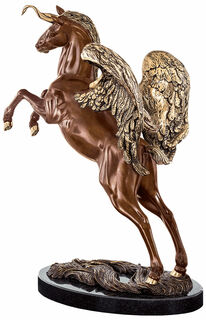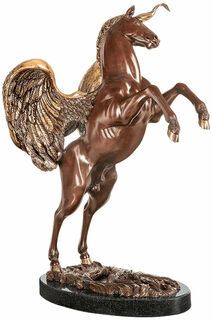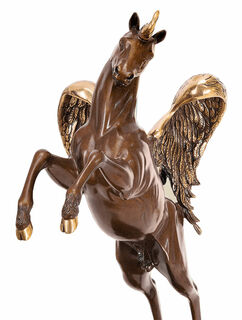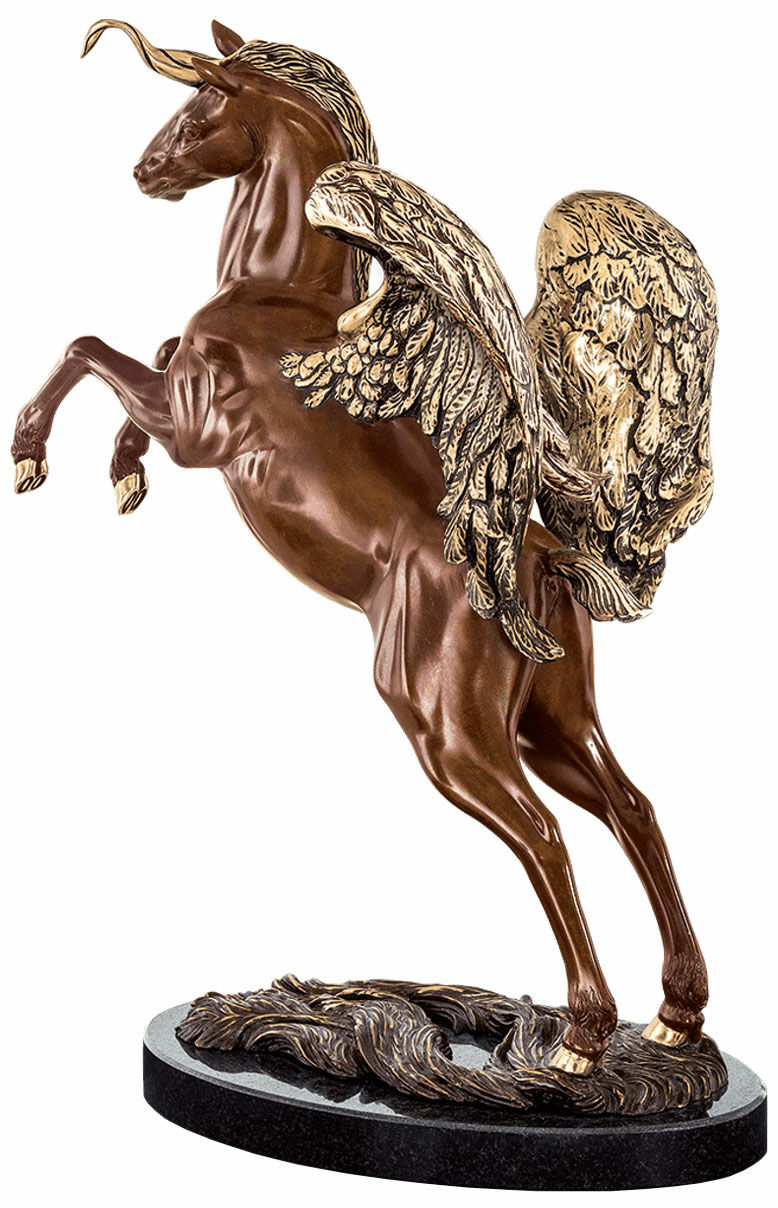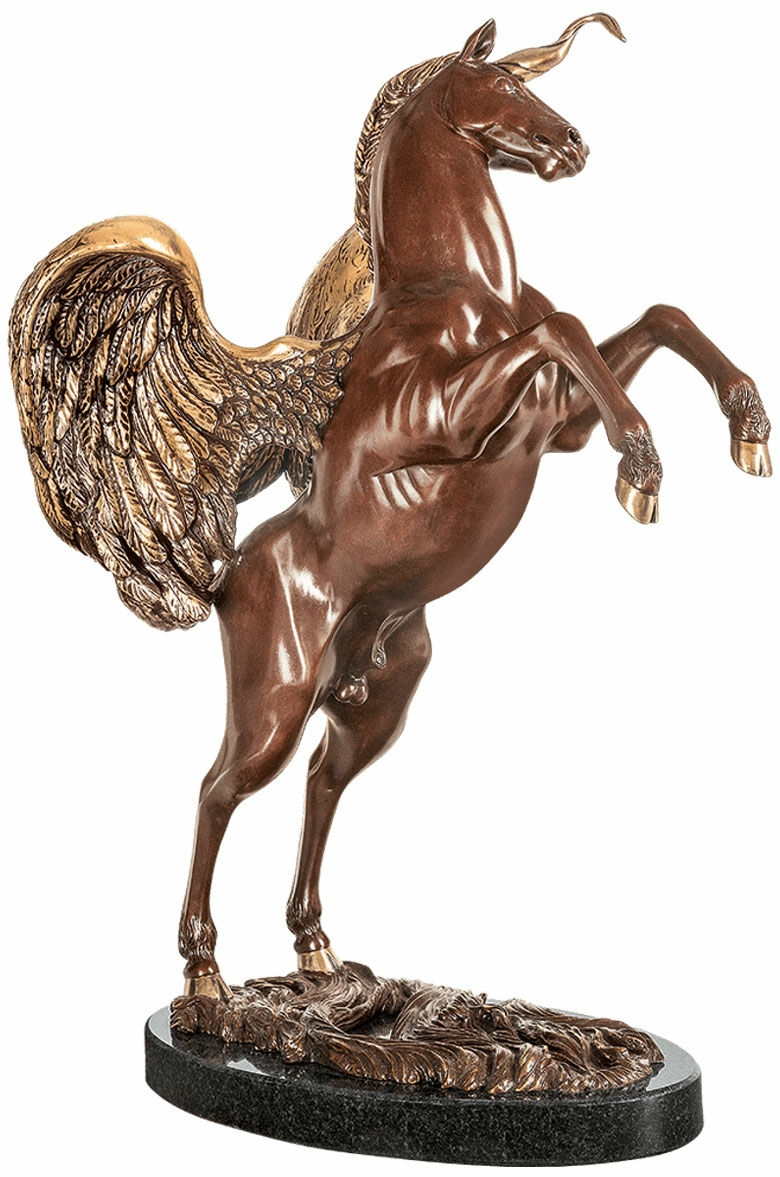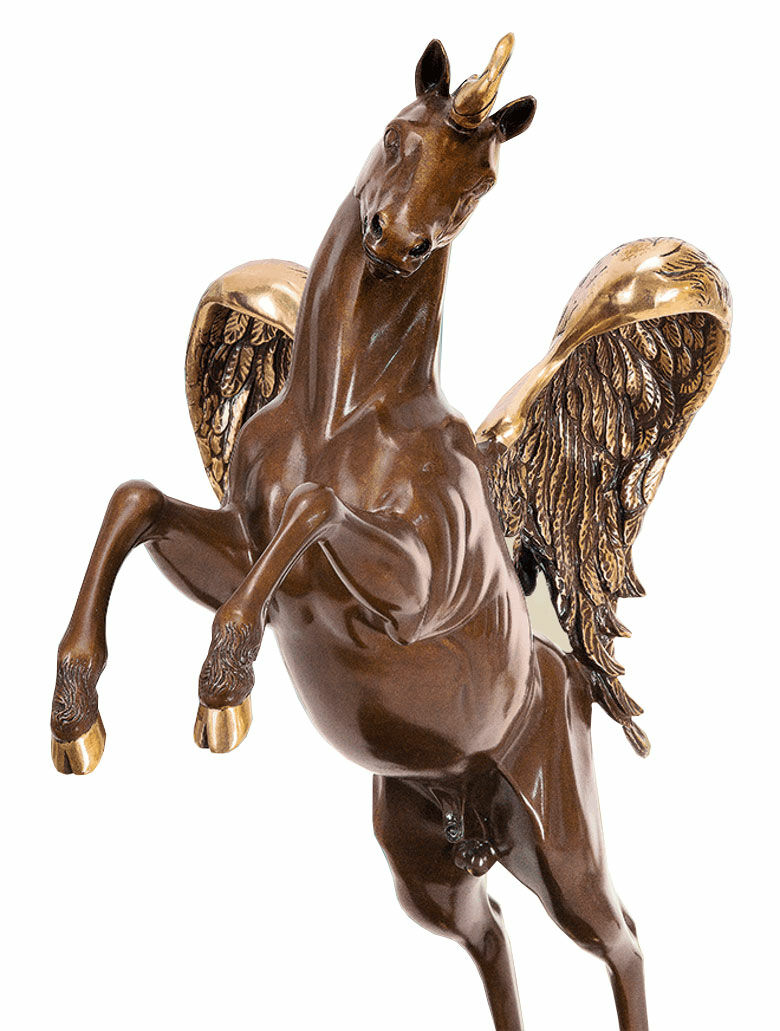Sculpture "My Unicorn Pegasus", bronze
Sculpture "My Unicorn Pegasus", bronze
Quick info
limited, 300 copies | numbered | signed | bronze | chased | patinated | size 39 x 19 x 29 cm (h/w/d) | weight 9.38 kg
Detailed description
Sculpture "My Unicorn Pegasus", bronze
Ernst Fuchs merges two mythical creatures of horse form: the unicorn and the winged horse Pegasus. Especially in heraldry, the unicorn is usually depicted to "jump" upright. Fuchs now raises it fully into the air as Pegasus. The idealist Pegasus is also considered to be a source of inspiration, as a hoofbeat on the mountain causes the muses' spring Hippukrene to spring up. In fact, both Pegasus and the unicorn have already arrived in the sky as constellations, with Pegasus bordering the constellation of the swan: If you look at the horn on the forehead of Ernst Fuchs' sculpture, you notice that it is not straight but curved like a swan's neck.
"The constant companion of my arts, the unicorn, is also the originator of all transformations. The unicorn is the heraldic sign of my efforts to create the total work of art. Now it has risen to become Pegasus. In my work, the two myths have now united. Even the horn has become recognisable in its resemblance to Lohengrin's swan as a sign of his arrival from the Grail. My unicorn Pegasus is the symbol of a new dimension of my arts and their summary in the total work of art. To the friends of my art and especially to you - most sincerely dedicated." (Ernst Fuchs)
Edition in bronze, cast using the Lost-Wax-Process, chiselled and patinated by hand. Limited to 300 numbered and signed copies. Size 39 x 19 x 29 cm (h/w/d). Weight 9.38 kg.
About Ernst Fuchs
1930-2015
Ernst Fuchs, born in Vienna in 1930, already presented his works to the public in 1946/47 together with other young artists during his studies at the Vienna Academy. He was one of the co-founders of the Vienna School of Fantastic Realism.
This art movement emerged in Vienna around 1945 and deliberately set itself apart from abstract art. In their works, the artists dealt with French Surrealism, the experiences of New Objectivity and metaphysical painting as well as the fantastic elements of Viennese pre-war art. Ernst Fuchs' work has had a decisive influence on our understanding of 20th-century art.
The motifs are complex allegories depicting human afflictions between life and death. Biblical and mythological representations dominate. The motifs of the Old and New Testaments are deliberately enigmatic and visionary in expression. These riddles are meant to bring knowledge and solution to the viewer as well as to the artist.
His engagement with the heterogeneous art traditions led him to his historicism. He mixed the styles, sometimes in a polemical way. In his first book, "Architectura Caelestis: Images of the Hidden Prime of Styles" first published in 1964, he set out his artistic conception.
The imaginative pictorial inventions, often alienated by surreal elements, evoke something mystical and often erotic. Fuchs' entire oeuvre is repeatedly permeated by biblical motifs. They all culminate in the unique book, the Ernst Fuchs Bible.
An alloy of copper with other metals (especially with tin) used since ancient times.
When casting bronze, the artist usually applies the lost-wax technique which is dating back more than 5000 years. It's the best, but also the most complex method of producing sculptures.
First, the artist forms a model of his sculpture. It is embedded in a liquid silicone rubber mass. Once the material has solidified, the model is cut out. The liquid wax is poured into the negative mould. After cooling down, the wax cast is removed from the mould, provided with sprues and dipped into ceramic mass. The ceramic mass is hardened in a kiln, whereby the wax flows out (lost mould).
Now we finally have the negative form, into which the 1400° C hot molten bronze is poured. After the bronze had cooled down, the ceramic shell is broken off and the sculpture is revealed.
Now the sprues are removed, the surfaces are polished, patinated and numbered by the artist himself or, to his specifications, by a specialist. Thus, each casting becomes an original work.
For lower-quality bronze castings, the sand casting method is often used which, however, does not achieve the results of a more complex lost-wax technique in terms of surface characteristics and quality.
Term for an art object (sculpture, installation), which is produced in multiple copies in a limited and numbered edition according to the artist‘s will.
Artist's multiples have been called the most accessible and affordable art on the market.
A plastic work of sculptural art made of wood, stone, ivory, bronze or other metals.
While sculptures from wood, ivory or stone are made directly from the block of material, in bronze casting a working model is prepared at first. Usually, it is made of clay or other easily mouldable materials.
The prime time of sculpture after the Greek and Roman antiquity was the Renaissance. Impressionism gave a new impulse to the sculptural arts. Contemporary artists such as Jorg Immendorf, Andora, and Markus Lupertz also enriched sculptures with outstanding works.

